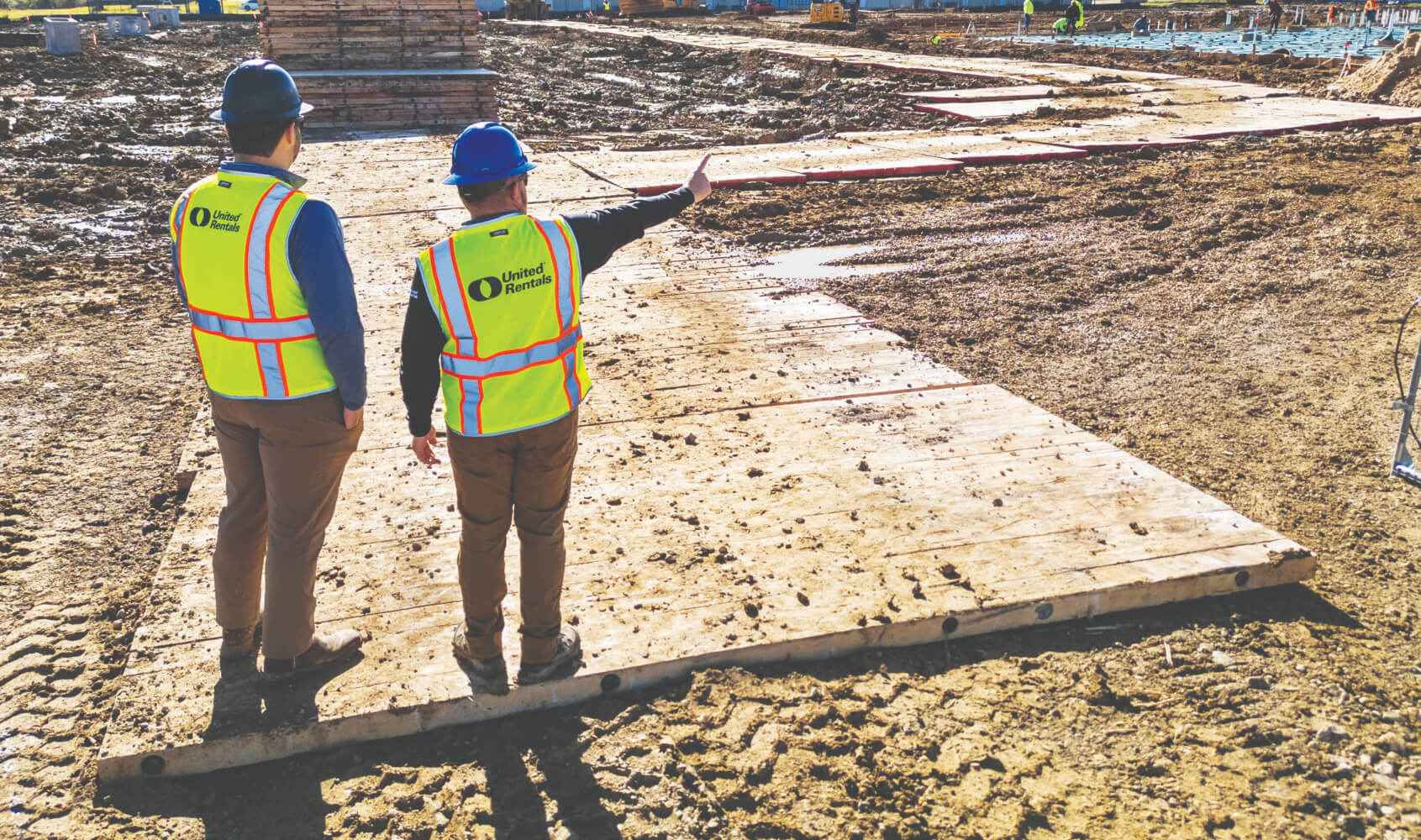
Mobile elevating work platforms (MEWPs) provide access to hard-to-reach places. But what happens when the jobsite turns muddy and equipment can’t easily get to the site? Or when it gets there but sinks into the ground during operation? If mud doesn’t halt work altogether, muddy conditions—and the aftereffects when the mud dries—can put operators, equipment and materials in harm’s way.
Installing ground protection mats at the start of a project creates sturdy, level surfaces that provide smooth passage across challenging terrain and stabilize equipment during operation, boosting safety and productivity.
These mats, made of hardwood, composite or other materials, can be used to quickly create temporary access roads as well as parking pads, laydown yards, staging areas and equipment platforms. Here’s a more detailed look at some of their benefits:
Providing Smooth Passage
Temporary access roads made of mats mitigate the hazards of traversing muddy, swampy, soft, rocky and uneven terrain. Timber mats provide stability and support for heavy equipment, especially on soft or uneven terrain. They minimize wear and tear on machines and often pay for themselves by preventing downtime due to bad weather.
On one construction project in humid southern Louisiana, mats allowed work to continue despite a series of downpours that dropped nearly a foot of rain over three weeks. After each rainstorm, the mats enabled lift operators to continue to track in materials and continue to erect steel. The project owner estimated that the mats prevented nine to 13 days of weather-related downtime in just three months.
Protecting Equipment and Materials
Operating heavy equipment on a muddy construction site often creates ruts that get deeper as the work progresses. Bottoming out in a rut can damage hydraulic lines, break axles and wheel bearings and rip off mufflers. Forklifts carrying high value materials may drop the load if they hit a rut or a roll of dried mud.
Ground protection mats prevent the formation of treacherous holes and bumps. When mats are used to create laydown yards and staging areas, materials and prefabricated components remain clean. Plus, leveraging mats eliminates the burden of installing, maintaining and removing gravel and can be more cost-effective.
Preventing Tip-Overs and Ejections
Installing the right mats on a jobsite reduces the risk of equipment tip-overs and worker ejections.
Level, stable temporary roads help keep equipment from tilting, and potentially tipping over, as it traverses the jobsite. By staving off ruts and mud rolls, roads constructed of mats also protect unsecured man lift occupants from being catapulted out of the basket and secured occupants from being thrown forcefully against it.
Heavy-duty timber mats used to create equipment work platforms stabilize boom lifts, telehandlers and other equipment during operation. They guard against a catastrophic tip-over caused by tires or tracks pressing into soft, unlevel ground and throwing off the machine’s center of gravity.
For equipment with outriggers, such as heavy telehandlers and some rough terrain scissor lifts, outrigger mats support the outriggers to increase safety. While outriggers can tolerate a certain degree of slope, they have been known to sink into very wet ground to the point of creating a hazard.

Protecting Subsurface Infrastructure
Some jobsites have subsurface infrastructure that was installed before construction began. It may sit only two or three feet below the surface. When ruts form, heavy equipment can depress them to the point of damaging drainpipes and electrical lines that lie beneath.
By preventing rut formation, ground protection mats head off damage to subsurface infrastructure and save contractors the cost of replacing it.
Reducing Environmental Damage
Mats also reduce the environmental impact of construction activities, which benefits companies on several fronts.
Heavy equipment rolling or sitting directly on the ground can compact the soil, increasing stormwater runoff. Ground protection mats reduce soil compaction by spreading out the pressure exerted by wheels and tracks. They can play a key role in helping contractors comply with a Stormwater Pollution Prevention Plan (SWPPP) and avoid hefty fines for noncompliance.
Limiting the disruption of soil and vegetation during construction also reduces the amount of restoration contractors might need to do at the end of a project.
Making Choices
Many different mat types and brands are available. Choosing the right mat for the application, and ordering mats in the right quantity is essential.
Light-duty timber mats are one go-to-choice for creating temporary access roads traveled by equipment. They are easy to install and relocate with equipment that’s typically available onsite, and they contour to the ground, which reduces slip and trip hazards.
Ground protection mats set projects up for success from day one. When equipment can easily and safely traverse the jobsite, even after a rainstorm, schedules and budgets benefit. When equipment-related accidents are avoided, workers stay healthy and companies maintain a good safety record. As an affordable, easy-to-implement solution to safety and productivity challenges, mats are well worth the investment.
Partnering with an experienced matting provider simplifies planning. A full-service rental company that carries a large inventory of mats from multiple brands is prepared to meet every project demand. Vendors with deep matting experience across multiple project types can help forecast a project’s mat needs and guide contractors to the most appropriate, cost-effective matting solutions for the project, soil and terrain. Some turnkey vendors also offer mat installation, mat removal and site restoration.